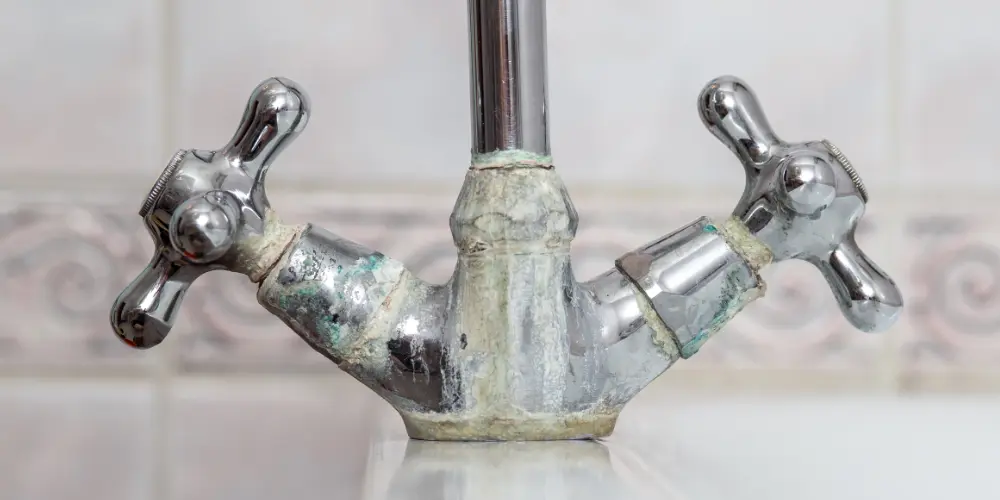Calcium makes your bones strong!
It also makes your plumbing weak.
Calcium buildup manifests as a chalky white residue on faucets and shower heads. Over time, it can reduce and even block the water flow in your home. It can also make your fixtures look dull and unsightly.
Thankfully, removing calcium buildup is a relatively simple DIY task.
What Causes Calcium Buildup?
Calcium buildup occurs when hard water containing high levels of calcium and magnesium flows through your faucet. When the water evaporates, it leaves mineral deposits and a chalky residue known as limescale. As these mineral deposits accumulate over the years, they restrict water flow.
How to Identify Calcium Buildup
Check for:
- White, chalky residue around the base and spout of the faucet.
- Reduced water pressure or uneven water flow.
- Stubborn spots that don’t disappear after regular cleaning.
Why Remove Calcium Buildup ASAP?
Leaving calcium buildup untreated can lead to:
- Reduced efficiency of your faucet.
- Potential damage to the fixture or seals.
- Aesthetic concerns that make your space look untidy.
Tools & Materials You’ll Need
Gather the following items:
- White vinegar
- Baking soda
- Lemon juice
- A soft cloth or sponge
- A toothbrush or small brush
- A container or plastic bag
- Rubber gloves
- A wrench or pliers (if needed)
4 Easy Steps to Remove Calcium Buildup
1. Prepare Your Workspace
Begin by clearing the area around your faucet. Remove any items that might get wet or damaged.
2. Apply White Vinegar
White vinegar is a powerful natural cleaner that can dissolve mineral deposits.
- Method A (for minor deposits): Dampen a cloth with vinegar and wrap it around the faucet. Leave it for 30–60 minutes, then scrub with a brush.
- Method B (for stubborn deposits): Fill a small plastic bag with vinegar, submerge the faucet, and secure it with a rubber band. Leave it overnight before scrubbing.
3. Baking Soda & Lemon Juice
For tougher stains, baking soda and lemon juice make an excellent cleaner:
- Mix baking soda and lemon juice to form a paste.
- Apply the paste to the affected areas.
- Scrub gently with a toothbrush.
- Rinse with water and wipe dry with a cloth.
This method also adds a fresh citrus scent to your cleaning process.
4. Check the Aerator
The aerator, located at the tip of the faucet, can accumulate deposits and affect flow:
- Unscrew the aerator with a wrench or pliers.
- Rinse it with vinegar or lemon juice.
- Use a brush to remove any remaining buildup.
- Reassemble and test the water flow.
Regularly cleaning the aerator ensures optimal water pressure.
Homemade Solutions vs. Commercial Cleaners
Benefits of Homemade Solutions
Natural solutions like vinegar and baking soda are:
- Affordable
- Eco-friendly
- Safe for most faucet finishes
They’re ideal for regular maintenance and minor buildups.
When to Use Commercial Cleaners
For severe limescale or when natural remedies fall short:
- Choose a cleaner specifically designed for calcium removal.
- Follow manufacturer instructions carefully.
- Use gloves to protect your skin from harsh chemicals.
Commercial cleaners can be effective, but they should be used cautiously.
Preventing Future Calcium Buildup
Regular Cleaning Routine
Implementing a regular cleaning routine can prevent buildup:
- Wipe down faucets after each use with a dry cloth.
- Clean with vinegar once a month to keep deposits at bay.
Water Softening Systems
If hard water is a persistent issue, consider installing a water-softening system. These systems reduce mineral content and protect your entire plumbing system from future buildups.
Monitor Water Quality
Regularly check your water quality and make adjustments as needed. Knowing your water’s hardness level helps you plan appropriate maintenance.
FAQs: Removing Calcium Buildup on a Faucet
Q: Can I use other types of vinegar?
You can use apple cider or wine vinegar as alternatives to white vinegar.
Q: Will these methods work on all faucet finishes?
These methods are safe for most finishes. However, always test a small area first and avoid using abrasive materials on delicate surfaces.
Q: How often should I clean my faucets to prevent calcium buildup?
We recommend incorporating a monthly cleaning routine using white vinegar or other natural solutions to prevent calcium buildup from solidifying. Regular cleaning maintains your faucet’s appearance and functionality.
Q: My shower head has calcium buildup. Can I use the same methods?
Yes, the same methods apply to shower heads. Submerge the shower head in a bag filled with vinegar, secure it with a rubber band, and leave it overnight. Scrub and rinse to remove any lingering deposits.
Q: How can I prevent damage to my faucet finish while cleaning?
Never use abrasive materials or harsh chemicals. Stick to soft sponges or cloths and natural cleaning solutions unless otherwise specified by the faucet manufacturer.
Q: Can these methods help with rust or corrosion?
These methods are focused on calcium buildup and may not be effective against rust or corrosion. Use a rust remover or seek professional advice.
Q: What should I do if my water flow doesn’t improve after cleaning?
Inspect your plumbing system for other obstructions or damage if water flow issues persist. You may need to consult a plumber for a more thorough investigation and repair.
Q: Are there preventative measures for appliances that use water, like dishwashers?
Using water conditioners or descaling agents can help prevent buildup inside appliances. Regularly cleaning appliance components according to the manufacturer’s instructions also minimizes mineral deposits.


